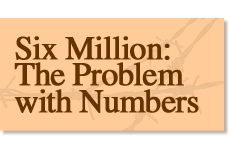 Identifying as a Jew
Identifying as a Jew


4 min read
Do the enormous numbers of the Holocaust depersonalize it?
One of the first ways in which people try to convey the enormity of the horror of the Holocaust is to recite a number. They will tell you that six million perished. But that is wrong – for a remarkable reason.
There is a law in the Jewish religion about counting people. If, for example, it has to be determined whether a sufficient number for a minyan, a quorum of 10 needed for prayer, is present, Jews will recite a special verse of ten words, apportioning a word to a person, to determine whether the right number has been reached. Never are you allowed to point to a person and say, "You're one, you're two, you're three" because that would turn a person into a number and not a individual created in the image of God.
Interesting, isn't it, that the first thing the Nazis did when they turned Jews into concentration camp inmates was to replace their names with a tattooed number. They would no longer have a personal identity but just a cold statistic suitable for extermination.
Six million is meaningless because we as men and women can't identify with a number. We can't empathize with a row of zeros. We can't picture the faces of mothers who had children torn from their breasts, to have their brains bashed in front of their eyes; we don't visualize little children tortured before they could ever enjoy their years of life and love. Six million is so incomprehensible that it is in fact beyond meaning.
That's why the world first began to understand the true dimension of the crime when the number became a name. We could understand the pain of Anne Frank, and it became not six million Jews, but Anne Frank with six million different names, dreams, and hopes never to be realized.
The Diary of Anne Frank
Anne Frank was sixteen years old when she died in the concentration camp in Bergen-Belsen in March 1945. All that remains of her incredible literary gifts, her sensitivity, and her insights is her diary – written while living in hiding in Amsterdam – which has become an international bestseller. For many people around the world, Anne Frank made the Holocaust real.
The famous photo of Anne Frank that adorns her diary has an inscription in her own writing: "This is a photo as I would wish myself to look all the time, then I would maybe have a chance to come to Hollywood."
With her we can feel the fear. We can get a small inkling of what it means not to leave the cramped quarters of a house for over two years and be deprived of your youth just because you are a Jew. Tears flow as we read her words of hope and know that in the end she will be betrayed, deported, and meet the same fate as her fellow Jews. We find it hard to agree with her conviction that "in spite of everything, I still believe that people are really good at heart." We cry with Anne Frank because we have come to know her. Yet her agony is miniscule compared to so many others. If only we knew them as well, we would begin to grasp the real meaning of six million victims.
When the Nazis broke into the house where Anne Frank was hiding, the S.S. man in charge picked up a portfolio and asked Otto Frank, Anne's father, whether there were any jewels in it. When he was told it contained only papers, he threw it on the floor, together with Anne's diary, and took only the silverware and the candlestick he found in the room. What an error of judgement. The diary proved far more valuable than all the silver and gold he possibly could have stolen.
The Hall of Children
That's probably why the most moving of all the exhibits at Yad Vashem, Israel's Holocaust museum in Jerusalem, is the wing known as the Hall of the Children. The darkness is claustrophobic and frightening. The only light comes from blinking stars in the ceiling, symbolic reminders of children who perished. The only sound that is heard is the recitation, not of prayers, but of names – an endless list of infants, children and teenagers, whose only legacy is the name they were given at birth.
To stand for a time and listen, to meditate and realize that every name was a person as precious to their loved ones as our children and grandchildren are to us is to recognize in yet another way that the phrase "six million" hardly begins to describe the loss of the Jewish people and the world.
from "The Complete Idiot's Guide to Jewish History and Culture," Alpha Books
